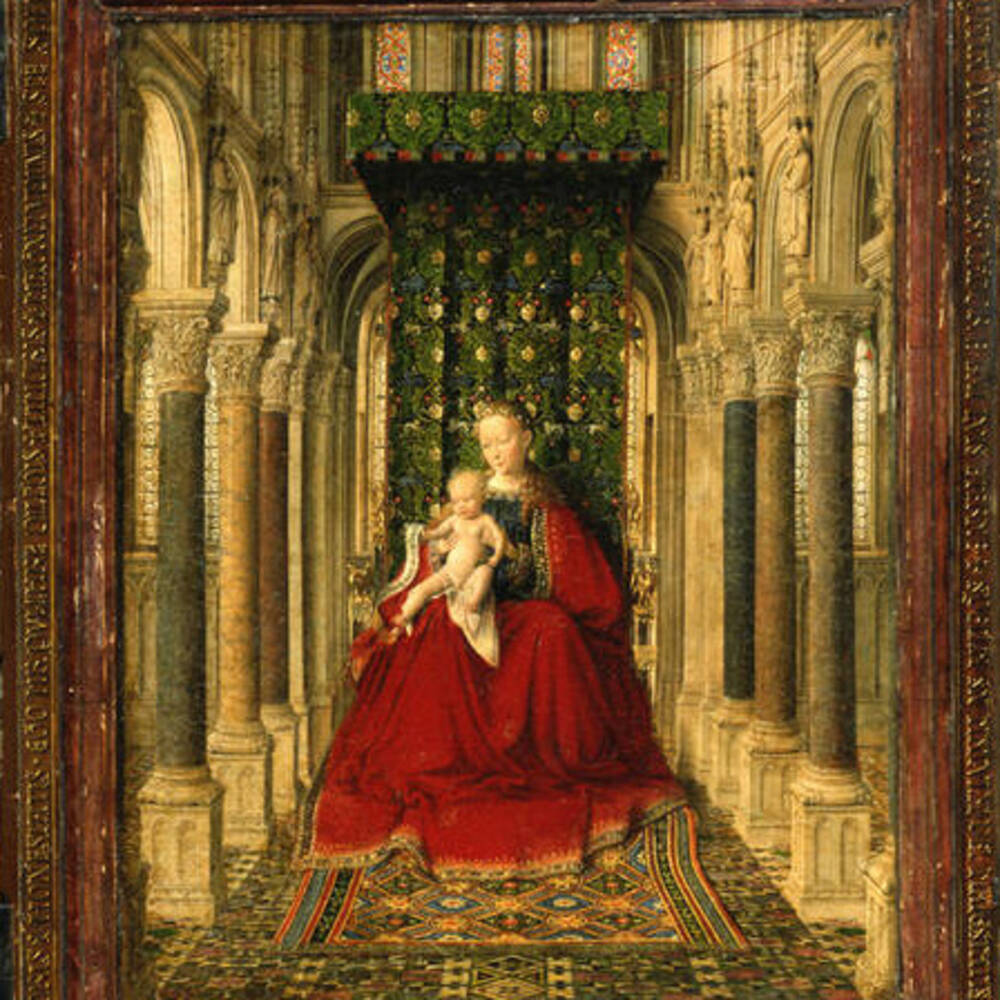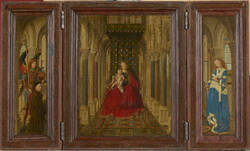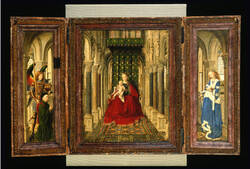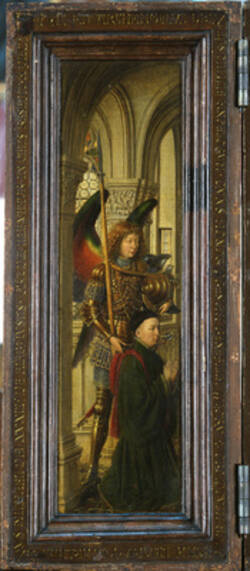This small winged altarpiece, which Van Eyck created for a private client, resembles an exquisite work of the goldsmith’s art. When opened, an illusionistic depiction of a church interior is revealed, at the centre of which is the enthroned Virgin with the infant Christ. In the side aisles appear the figures of the Archangel Michael and St Catherine. The Annunciation scene on the outside of the wings, executed in grisaille technique (‘grey’ painting’), imitates alabaster or ivory sculptures.
Further Media






The narrative begins on the altarpiece’s outer panels with the Annunciation. The Archangel Gabriel appears to the Virgin Mary, telling her God has chosen her to bear his son. The central panel shows the angel’s words have come true: Mary is holding the Christ Child on her lap. The Christ Child has a banderole with an inscription invoking the words and deeds of his future life. ‘Learn from me,’ it says in Latin, ‘for I am meek and lowly in heart.’ Various symbols allude to the end of Jesus’s life. Either side of Mary, the throne’s frame is decorated with tiny scenes of sacrifice. A little pelican stands on the arm of the throne directly to the left of the baby Jesus. In the medieval period, the pelican was believed to cut open its own breast with its beak to feed its blood to its young, and so it became a symbol of Christ’s sacrifice on the cross.
When this work was painted, Catherine – on the right-hand wing – was the most highly venerated saint after the Virgin Mary. According to legend, when 50 scholars came to persuade Catherine to renounce her Christian faith, she convinced them all to convert. The book in Catherine’s hand represents learning and the wheel at her feet is a reminder of how the pagan Romans tortured her on a spiked wheel.
The Archangel Michael, on the left wing, was believed to carry the souls of the deceased to heaven, and led the forces of good in the battle with the powers of hell. With a gentle touch of his hand, Michael guides the donor to devout worship of the sacred mysteries of Christianity.
Van Eyck has set the lay donor very close to the saint – at that time, rather unusual. This may well show the influence of a movement known as the Devotio Moderna – Modern Devotion. Originating in the Low Countries, the movement advocated religious reform and a return to genuinely pious practices. Its key principle was direct access to God even without the Church as an intermediary. Van Eyck’s positioning of his enthroned Mary also emphasises the direct connection between God and the faithful – her throne is set where the church altar stood for lay worshippers.
Van Eyck’s altarpiece consists of just three oak panels. The frames were not prepared separately, but shaped together with the painting surface from the panels of wood. To do this, the panels had to be prepared by planing down the wood in the centre, creating an even painting surface. This area was surrounded by the wood for the frames. Only when these were finished did van Eyck began painting the panels – as is also evident from his inscriptions decorating the frames. Written in gilded letters, the inscriptions are taken from the liturgies spoken on the feast days of the respective saint. The letters are so delicate, they seem to be engraved in metal.
Since the altar panels are hinged, the wings can be open and closed. Most polyptych altarpieces in churches were normally kept closed, displaying the scenes on the outer wings. The faithful could only view the inner panels when the altarpieces were opened to celebrate church festivals.
- Location & Dating
- 1437
- Material & Technique
- Oil on oak panel
- Dimenions
- 33 x 27,5 cm, die Flügel je 33 x 13,5 cm
- Museum
- Gemäldegalerie Alte Meister
- Inventory number
- Gal.-Nr. 799